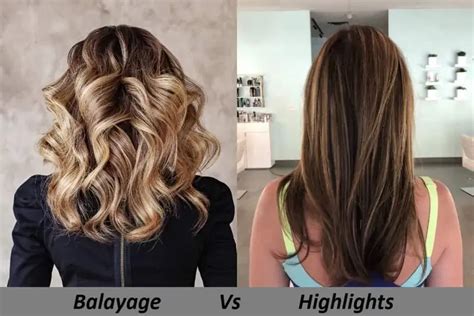Introduction
The world of hair coloring is vast and ever-evolving, with countless techniques to choose from. Among the most popular are balayage and highlights, both of which aim to add dimension, depth, and texture to your locks. But what’s the difference between the two? This comprehensive guide will provide a side-by-side comparison of balayage vs. highlights, helping you make an informed decision.

Balayage
Definition
Balayage is a French hair coloring technique that translates to “to sweep” or “to paint.” It involves using a sweeping motion to apply color to the mid-lengths and ends of the hair, creating a natural, sun-kissed effect.
Application
- Hair is divided into sections.
- Color is brushed onto the hair in a sweeping motion, leaving the roots untouched.
- Multiple shades may be used to create a more natural look.
- The color is left to process for a specific amount of time.
- Hair is rinsed and styled.
Highlights
Definition
Highlights involve applying a lighter color to small sections of hair, creating a more defined contrast. They can be placed strategically to frame the face, add volume, or cover gray hairs.
Application
- Hair is sectioned.
- Thin strands are pulled through a cap or foil.
- Color is applied to the strands, covering them completely.
- The color is left to process for a specific amount of time.
- Hair is rinsed and styled.
Side-by-Side Comparison
| Feature | Balayage | Highlights |
|---|---|---|
| Application Technique | Sweeping | Foiling or capping |
| Coverage | Mid-lengths and ends | Small, defined sections |
| Strand Thickness | Varies | Consistent |
| Blending | Gradual, natural-looking | Defined, contrasting |
| Root Area | Untouched | Covered or lightened |
| Maintenance | Requires touch-ups every 3-6 months | Requires touch-ups every 4-8 weeks |
| Cost | Generally more expensive | Generally less expensive |
| Results | Subtle, sun-kissed effect | Bold, contrasting effect |
Pain Points and Motivations
Pain Points
- Balayage can be time-consuming to apply.
- Highlights can damage hair if not applied properly.
- Both techniques can be expensive, especially for regular maintenance.
Motivations
- Balayage creates a natural, low-maintenance look.
- Highlights add volume and dimension to hair.
- Both techniques can be used to cover gray hairs.
Step-by-Step Approach
Balayage
- Section hair and create a sweeping motion with a brush.
- Apply color to the hair in thin sections.
- Work your way up the hair shaft, blending the color.
- Process the color and rinse.
Highlights
- Section hair and pull strands through a cap or foil.
- Apply color to the strands and cover them completely.
- Process the color and rinse.
Pros and Cons
Balayage
Pros:
- Natural-looking results
- Low maintenance
- Suitable for all hair types
Cons:
- Time-consuming application
- Can be difficult to achieve desired results at home
Highlights
Pros:
- Bold, defined results
- Adds volume and dimension
- Covers gray hairs
Cons:
- Can damage hair
- High maintenance
- May not be suitable for all hair types
Creative Applications
Balayage and highlights can be used in countless creative ways to enhance your hair.
- Reverse Balayage: Darker shades are applied to the ends, creating a gradient effect.
- Ombré Highlights: Different shades are blended together to create a gradual transition from root to tip.
- Peekaboo Highlights: Hidden highlights are placed underneath the top layer of hair, creating a subtle peek-a-boo effect.
- Face-Framing Balayage: Color is applied to the front sections of the hair to frame the face.
Conclusion
Whether you choose balayage or highlights depends on your individual preferences, hair type, and desired results. Balayage offers a natural, low-maintenance look, while highlights provide bold, contrasting effects. By understanding the key differences between the two techniques, you can make an informed decision and achieve the perfect hair color for your needs.
